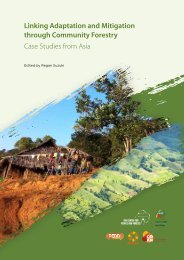Desktop Study on - Regional Climate Change Adaptation ...
Desktop Study on - Regional Climate Change Adaptation ...
Desktop Study on - Regional Climate Change Adaptation ...
You also want an ePaper? Increase the reach of your titles
YUMPU automatically turns print PDFs into web optimized ePapers that Google loves.
<str<strong>on</strong>g>Desktop</str<strong>on</strong>g> <str<strong>on</strong>g>Study</str<strong>on</strong>g><br />
evapotranspirati<strong>on</strong>. The fresh groundwater storage<br />
is estimated at 5,000 billi<strong>on</strong> m3 (MOSTE, 2000)<br />
Range of Studies Reviewed and<br />
Methods Applied<br />
A range of studies and applied methods were<br />
reviewed for analyzing the Ind<strong>on</strong>esian water sectors’<br />
situati<strong>on</strong> in view of climate change and are shortly<br />
presented in the following.<br />
A regi<strong>on</strong>al hydrologic-atmospheric model of<br />
Peninsular Malaysia called ‘Regi<strong>on</strong>al Hydroclimate<br />
Model of Peninsular Malaysia (RegHCM-PM)’ was<br />
developed by the Nati<strong>on</strong>al Hydraulic Research<br />
Institute of Malaysia (NHRIM) to downscale the<br />
global climate change simulati<strong>on</strong> data (Canadian<br />
GCM1 current and future climate data) that are at very<br />
coarse resoluti<strong>on</strong> (~ 410km), to Peninsular Malaysia<br />
at fine spatial resoluti<strong>on</strong> (~9km) and to be able to<br />
quantify the impact of the complex topographical<br />
and land surface features of Peninsular Malaysia<br />
<strong>on</strong> its climate c<strong>on</strong>diti<strong>on</strong>s (Zakaria and Jamalluddin,<br />
2007).<br />
In the climate change scenarios developed by<br />
the Malaysian Meteorological Department, the<br />
impact of global warming <strong>on</strong> the m<strong>on</strong>so<strong>on</strong>s over<br />
the Malaysian regi<strong>on</strong> is studied by using twelve<br />
coupled Atmosphere-Ocean General Circulati<strong>on</strong><br />
Models (AOGCMs). However, for temperature and<br />
rainfall analysis, <strong>on</strong>ly nine different AOGCMs were<br />
chosen in this study. The AOGCMs used in this study<br />
are from the c<strong>on</strong>tributi<strong>on</strong> of the Coupled Model<br />
Inter-comparis<strong>on</strong> Project (CMIP) to the IPCC 4th<br />
Assessment Report. The AOGMs and the instituti<strong>on</strong><br />
which developed them are: CNCM3 by Meteo-France,<br />
MRCGCM by the Meteorological Research Institute<br />
from Japan, FGOALS by the Institute of Atmospheric<br />
Physics from China, FCM20 by NOAA/GFDL from<br />
USA, HADCM3 by Hadley Centre from UK, MIHR by<br />
JAMSTEC form Japan, MPEH5 by Max Plank Institute<br />
from Germany, NCPCM by NCAR form USA, CSMK3<br />
by CSIRO Atmospheric Research, CGMR by Canadian<br />
Centre for <strong>Climate</strong> Modelling & Analysis, and MIMR<br />
by University Of Tokyo. All the models start their<br />
integrati<strong>on</strong> from the ‘20th Century <strong>Climate</strong> in<br />
Coupled Model’ (20C3M) run, in which the level of<br />
anthropogenic forcing is based <strong>on</strong> historical data of<br />
the late 19th century through the 20th century.<br />
Impacts <strong>on</strong> the Water Sector<br />
The Initial Nati<strong>on</strong>al Communicati<strong>on</strong> gathers some<br />
of the main impacts <strong>on</strong> water resources because of<br />
the change <strong>on</strong> climate that result for the data of the<br />
models described before. Under the 2 x CO2 scenarios<br />
there may be an increase of 10% to 20% in storm<br />
magnitude that would result in double designed<br />
storm frequency or return period. These preliminary<br />
results provide at least a qualitative trend of the<br />
climate change induced impact <strong>on</strong> rainfall intensities<br />
that will end up in more frequency and severity of<br />
floods due to extreme events. Taking into account<br />
that erosi<strong>on</strong> and sedimentati<strong>on</strong> rates increase during<br />
and after str<strong>on</strong>g storm, there will be a higher risk<br />
of slope failures of riverbanks and hills, faster rate<br />
of sedimentati<strong>on</strong> of reservoirs and channels, and<br />
more extensive loss of soil nutrients. For example, in<br />
the Kelantan River, a 20% of increase <strong>on</strong> discharge<br />
would cause a sediment load increase of 33%. In<br />
Sabah and Sarawak, an increase of 20% in high flow<br />
magnitudes and frequencies will translate to a 44%<br />
surge in sedimentati<strong>on</strong> loads (MOSTE, 2000). There<br />
are aspects of land use and climate change in the l<strong>on</strong>g<br />
term such as, soil erosi<strong>on</strong> or chemical pois<strong>on</strong>ing that<br />
combined with some others related to daily quality<br />
of life such as, water polluti<strong>on</strong>, shortage of food or<br />
resources, produce effects difficult to predict such<br />
as, natural and envir<strong>on</strong>mental catastrophes in recent<br />
times- floods, landslides, l<strong>on</strong>g periods of drought etc.<br />
The floods incidence happened in the southern states<br />
of Malaysia, involving Negeri Sembilan, Melaka,<br />
Johor and Pahang. Johor was the worst affected,<br />
heavy rainfall in Southern Malaysia, was exaggerated<br />
because of with poor drainage systems. Without<br />
adequate measures floods may cause displacement<br />
of people, damaged infrastructures and losses of<br />
agricultural producti<strong>on</strong> from eroded and inundated<br />
lands (Kamal, 2007).<br />
Annual rainfall will increase a 10% for Kelantan,<br />
Terengganu and Pahang and decrease 5% for Selangor<br />
and Johor. Also is expected an increase in mean<br />
m<strong>on</strong>thly rainfall over the North East Coastal regi<strong>on</strong><br />
and over Kelantan while over Selangor and Johor<br />
a decrease is expected (Zakaria and Jamalluddin,<br />
2007). Because of changes in climate c<strong>on</strong>diti<strong>on</strong>s, the<br />
total surface runoff will also be affected inducing at<br />
the same time variati<strong>on</strong>s <strong>on</strong> water availability. In the<br />
Initial Nati<strong>on</strong>al Communicati<strong>on</strong> is set that for a 1°C<br />
increase in temperature there is an increase in the<br />
potential evapotranspirati<strong>on</strong> (PET) of between 3%<br />
and 9%; for a 3°C the PET is expected to rise from 9%<br />
to 13%, which represents potentially about 170 mm<br />
of extra moisture loss. In wet m<strong>on</strong>ths, for an increase<br />
of 1ºC to 3ºC, the l<strong>on</strong>g-term runoff will be reduced<br />
between 1% and 5% and between 2% and 17%,<br />
respectively, but in dry m<strong>on</strong>ths, the scenarios show<br />
a reducti<strong>on</strong> between 1% and 16% and between 1%<br />
and 24% respectively. With a reducti<strong>on</strong> in rainfall<br />
of 10%, the runoff will be reduce between 12% and<br />
142

















